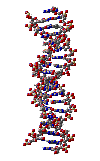|
The immune system in hemochromatosis – more than meets the eye? (07/2005)
Hereditary haemochromatosis (HH) is a disease characterised by excessive absorbance and storage of iron in the body, which results from a mutation in HFE, a gene involved in iron regulation. In addition, HH patients have an abnormal immune system (IS), and it has been suggested that the IS is also involved in HH iron deregulation. And now, research by a team of Portuguese scientists about to be published on the 1st of August issue of the journal Blood1, shows, that the HFE gene seems to be involved, not only in iron regulation, but also in the immune response. The discovery not only helps to understand better the mechanism behind the disease, but proves, for the first time, the existence of a molecular link between iron homeostasis and the IS, suggesting what a few scientists have proposed before - that the IS might be involved in more functions in the body beside the fight against infection.
Hereditary hemochromatosis is the most common genetic illness among people of North European ancestry where it affects as many as 1 in 200-300 individuals. The disease results in excessive storage of iron in the body tissues leading to damage, and if not treated, organ failure and even death. Symptoms vary from mild to life-threatening heart and liver disease, arthritis or even diabetes mellitus depending on the damaged organ.
An interesting characteristic of the disease is that individuals with the same HFE mutations can, nevertheless, present a large range of disease severities, what shows that other factors, beside HFE, seem to be involved in disease outcome. And in fact HH patients are also immuno-suppressed presenting, among other problems, low numbers of specific subsets of white blood cell, the IS “responders” against intruders. Research seems to indicate that these immunological problems are involved, together with the mutated HFE gene, in the excessive absorbance and storage of iron observed in HH although the reason behind such deficiencies is unknown
But now Sérgio F. De Almeida, Isabel F. Carvalho, Maria De Sousa and colleagues at the Institute for Molecular and Cell Biology (IBMC) and ICBAS, Oporto, Portugal and The Netherlands Cancer Institute in Amsterdam, might have put together the first piece of the puzzle.
The team of scientists decided to compare the blood of HH patients carrying the C282Y mutation - which is responsible for 80% of the HH cases - with the blood of healthy controls. To their surprise, they found that in the patients’ blood, a key component of the immune response, the MHC-I molecule, was found to be unstable and therefore non-functional. MHC molecules (I and II) are crucial for the immune response where they bind and “present” disease-inducing-intruders to white blood cells, the “responders” of the IS. When the complex intruder-MHC engages with a “fitting” white blood cell, this leads to the activation of the immune response.
Confirming the hypothesis that this immune abnormality resulted from the mutated HFE gene, patients with two mutated copies of the gene had a much higher number of non-functional MHC-I molecules than patients with one mutated and one normal copy
To Dr. Hal Drakesmith, a molecular biologist working on hemochromatosis at Oxford University, this is no doubt an important discovery “we only had observational studies on a possible crosstalk between iron metabolism and the IS in HH, this is the first molecular biology data showing a very clear effect… the fact that the work is done with cells, straight from the individual, gives further credibility to the results and makes us believe that there is definitely something going on…” he says.
For Prof. De Sousa this work is the beggining of the end in a long path trying to prove that the IS has a role in iron regulation. “Already in 1978 I got tired of believing that the IS was only for what the books said, how could all the species that do not have a complex IS survive?”, she says. And while studying cell migration in the body she realised that in some diseases, where lymphocytes accumulate in “wrong” places, these places had very high iron concentrations. "Iron , or potential iron toxicity coming from the red blood cell circulation, seemed a good reason for having a circulation of lymphocytes”, she says.
The truth is that the more complex a biological system becomes, more energy it needs for its sustainance, and as result, organisms only tend to become more complex if that gives them survival advantage. And if simpler IS could fight infection efficiently, as De Sousa says, then more complex IS, like the ones in mammals, might in fact have additional functions as important for survival.
And now, almost thirthy years after, the puzzle seems to start to take shape with Almeida, Carvalho, De Sousa and colleagues‘ latest results, which provide the first molecular evidence of a direct link between iron homeostasis and the IS.
“The importance of this paper is that HFE, a protein generally thought to affect iron metabolism now is shown to have a clear immunological function through MHC class I” says De Sousa.
If De Sousa’s theory proves to be correct - that the IS is involved in maintaining iron homeostasis - this will challenge one of the better guarded dogmas of immunology/biology - that this biological system evolved in order to fight infection and will no doubt raise much discussion. Dogmas are after all difficult to change. But whatever happens, this is no doubt a very interesting story and one worthwhile to keep an eye on.
Piece researched and written by: Catarina Amorim ( catarina.amorim@linacre.ox.ac.uk)

1 Blood (2005) 1st August
" HFE cross-talks with the MHC class I antigen presentation pathway”
Original paper’s authors
S. F. de Almeida,-
Maria de Sousa mdesousa@ibmc.up.pt
Link to the original paper
|
In collaboration with the Observatório da Ciência e do Ensino Superior (OCES)
Financed by the Fundação para a Ciência e Tecnologia (FCT) |





